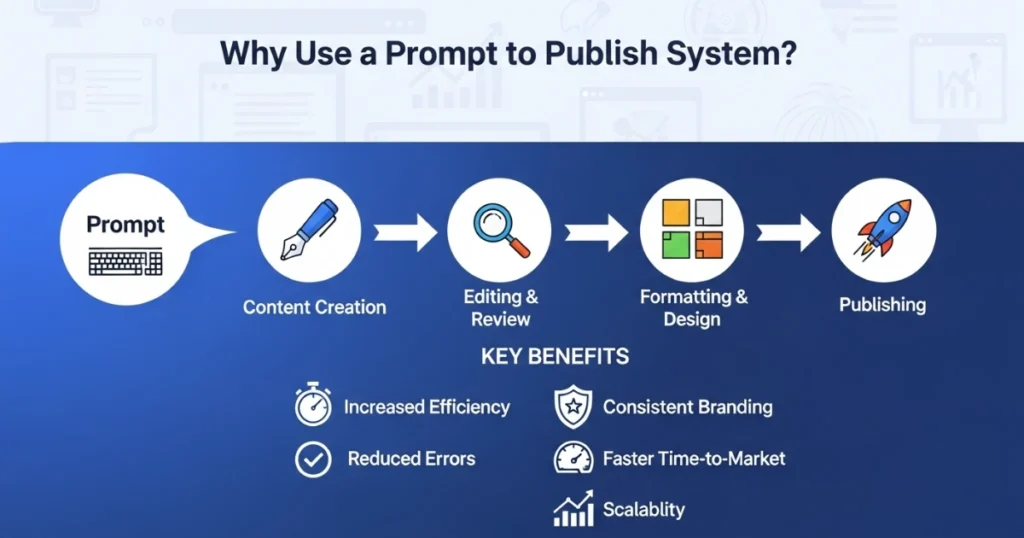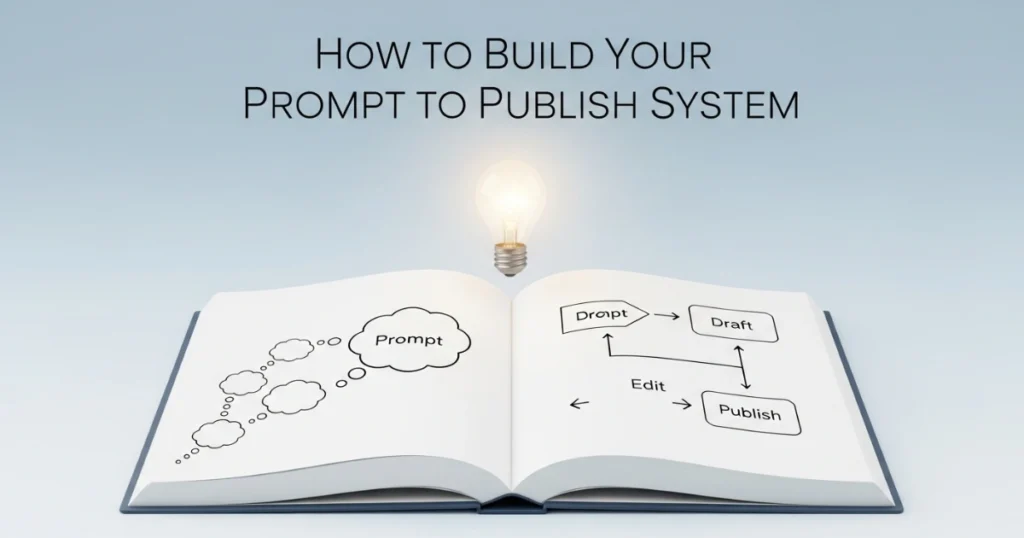
AI Content Creation
Prompt to Publish System: Streamlining Content Creation in 2025

Contents
In today’s fast-paced digital world, the prompt to publish system has emerged as a game-changer for content creators, bloggers, and marketers aiming to maximize efficiency. This innovative approach allows users to transform ideas into polished, publish-ready content in record time. By leveraging advanced tools, automation, and structured workflows, the prompt to publish system minimizes manual effort while ensuring high-quality output. Whether you’re a solo blogger or part of a large content team, adopting this system can save maximum time, letting you focus on strategy and engagement rather than repetitive tasks. In this article, we’ll explore how the prompt to publish system works, its benefits, and practical steps to implement it for your blog in 2025.
What Is a Prompt to Publish System?
A prompt to publish system is a structured process that takes raw ideas or prompts and converts them into publishable content with minimal manual intervention. By integrating tools like AI writing assistants, content management systems (CMS), and automation platforms, this system streamlines every stage of content creation—from ideation to publishing. The goal is to save maximum time while maintaining quality, consistency, and SEO optimization.
Key Components of the System
- Idea Generation Tools: Platforms like AnswerThePublic or BuzzSumo help identify trending topics and keywords.
- AI Writing Assistants: Tools such as Grok or Jasper generate drafts based on prompts, reducing writing time.
- Content Optimization Software: SEO tools like Yoast or SurferSEO ensure content aligns with search engine algorithms.
- Automation Platforms: Systems like Zapier or Make automate tasks like scheduling posts or sharing on social media.
- CMS Integration: Platforms like WordPress or HubSpot allow seamless publishing and management.
Why Use a Prompt to Publish System?
The digital landscape in 2025 demands speed and quality. Here’s why adopting a prompt to publish system is essential:

1. Saves Maximum Time
Manual content creation is time-consuming. Researching, writing, editing, and publishing can take hours or days. A prompt to publish system automates repetitive tasks, such as keyword research or formatting, allowing you to produce content in a fraction of the time. For instance, AI tools can generate a 1,000-word draft in minutes, leaving you more time for refinement.
2. Enhances SEO Performance
SEO is critical for driving traffic to your blog. The prompt to publish system integrates SEO tools to optimize content for search engines. By analyzing keywords, readability, and meta tags, these tools ensure your content ranks higher on Google, attracting more organic visitors.
3. Improves Consistency
Consistency is key to building a loyal audience. A prompt to publish system enables you to maintain a regular posting schedule by automating workflows and reducing bottlenecks. This ensures your blog stays active and relevant.
4. Scales Content Production
For businesses or large blogs, scaling content creation is a challenge. The prompt to publish system allows teams to produce high volumes of content without sacrificing quality. Automation and AI handle repetitive tasks, freeing up human resources for creative work.
5. Reduces Costs
Hiring writers, editors, and SEO specialists can be expensive. By automating parts of the process, the prompt to publish system cuts costs while delivering professional results. Small businesses and solo bloggers can compete with larger players without breaking the bank.
How to Build Your Prompt to Publish System
Creating a prompt to publish system tailored to your blog requires careful planning. Below, we outline a step-by-step guide to set up a system that saves maximum time and delivers results.

Step 1: Define Your Content Goals
Before implementing the system, clarify your objectives. Are you aiming to increase traffic, generate leads, or build brand authority? Your goals will shape the tools and processes you choose. For example, a lead-generation blog may prioritize gated content, while a lifestyle blog may focus on shareable posts.
Step 2: Choose the Right Tools
Selecting the right tools is critical for a successful prompt to publish system. Here’s a breakdown of essential categories:
- Ideation Tools: Use AnswerThePublic or Google Trends to identify popular topics in your niche. These platforms provide insights into what your audience is searching for.
- Writing Tools: AI-powered tools like Grok or Copy.ai can generate drafts based on simple prompts. For example, inputting “Write a blog post about sustainable fashion” can yield a structured draft in minutes.
- SEO Tools: Tools like Ahrefs or SEMrush help identify low-competition keywords with high search volume. Integrate these into your content to boost rankings.
- Automation Tools: Platforms like Zapier automate tasks like posting to social media or sending email newsletters after publishing.
- CMS Platforms: WordPress, with plugins like Yoast, is ideal for managing and publishing content efficiently.
Step 3: Create a Workflow
A streamlined workflow is the backbone of the prompt to publish system. Here’s a sample workflow:
- Ideation: Use tools to generate a list of trending topics and keywords.
- Prompt Creation: Write clear, specific prompts for AI tools (e.g., “Write a 500-word article on eco-friendly home decor, optimized for SEO”).
- Drafting: Generate a draft using AI writing tools.
- Editing: Refine the draft for tone, accuracy, and brand voice. Use Grammarly or Hemingway for readability.
- SEO Optimization: Run the draft through SurferSEO or Yoast to ensure keyword density and meta tags are optimized.
- Publishing: Upload the content to your CMS and schedule it for release.
- Promotion: Automate social media posts and email campaigns using tools like Buffer or Mailchimp.
Step 4: Test and Refine
Once your system is in place, test it with a few blog posts. Monitor metrics like time spent per post, traffic, and engagement. Adjust your tools or workflow based on performance. For example, if drafts lack depth, tweak your prompts to be more specific.
Step 5: Scale Up
As you refine your prompt to publish system, scale it to produce more content. Batch-process multiple posts at once or delegate tasks to team members. Automation ensures consistency even as volume increases.
Best Practices for a Prompt to Publish System
To maximize the efficiency of your prompt to publish system, follow these best practices:

1. Craft Clear Prompts
The quality of AI-generated content depends on the prompt. Be specific about word count, tone, and target audience. For example, “Write a 700-word blog post for beginner gardeners on low-maintenance plants” yields better results than a vague prompt.
2. Maintain Brand Voice
AI tools may produce generic content. Edit drafts to align with your brand’s tone—whether it’s conversational, professional, or witty. This ensures your content feels authentic to your audience.
3. Optimize for SEO
Incorporate your main keyword, “prompt to publish system,” naturally throughout the article. Aim for a 1% keyword density (approximately 30-35 uses in a 3,000-word article). Use related keywords like “content automation” or “AI writing tools” to enhance relevance.
4. Leverage Analytics
Use Google Analytics or your CMS’s built-in tools to track performance. Monitor metrics like page views, bounce rate, and time on page to gauge the effectiveness of your content.
5. Stay Updated
The digital landscape evolves rapidly. Regularly update your tools and strategies to align with the latest SEO trends and platform updates. For instance, Google’s algorithm changes may require adjustments to your keyword strategy.
Challenges and Solutions
While the prompt offers numerous benefits, it’s not without challenges. Here are common issues and how to address them:

Challenge 1: Generic AI Content
AI-generated drafts can lack originality. Solution: Customize prompts with specific details about your niche and audience. Edit drafts to add unique insights or personal anecdotes.
Challenge 2: Over-Reliance on Automation
Automation can lead to errors if not monitored. Solution: Assign a team member to review AI-generated content for accuracy and relevance before publishing.
Challenge 3: High Initial Setup Time
Setting up a prompt to publish system requires time and investment. Solution: Start small with one or two tools, then gradually expand as you see results. Focus on tools with free trials to test their value.
Challenge 4: Keyword Stuffing
Overusing keywords can harm SEO. Solution: Maintain a natural flow and use synonyms or related terms to keep content engaging.
Real-World Examples
To illustrate the power of the prompt to publish system, let’s look at two examples:

Example 1: Solo Blogger
Jane, a travel blogger, used a prompt to publish system to increase her output from one post per week to three. By using AnswerThePublic for topic ideas, Grok for drafting, and Yoast for SEO, she reduced her content creation time by 60%. Her blog’s traffic doubled within three months.
Example 2: Marketing Agency
A digital marketing agency implemented a prompt to publish system to handle client blogs. By automating keyword research with Ahrefs and scheduling with Buffer, they produced 20 posts per week, saving maximum time and boosting client satisfaction.
Future of the Prompt to Publish System

As technology advances, the prompt to publish system will become even more powerful. AI models like Grok 3 are improving in natural language understanding, enabling more nuanced content creation. Additionally, advancements in automation platforms will further reduce manual tasks, allowing creators to focus on strategy and creativity. By 2026, we expect tighter integration between AI tools, CMS platforms, and analytics, making the system even more seamless.
Conclusion
The prompt to publish system is revolutionizing content creation in 2025. By combining AI, automation, and SEO tools, this system saves maximum time, enhances quality, and scales production. Whether you’re a solo blogger or a large team, implementing a prompt to publish system can transform your workflow, boost traffic, and grow your audience. Start by defining your goals, selecting the right tools, and refining your process. With the right approach, you’ll create high-quality content faster than ever before.


Prompt to Publish System: Streamlining Content Creation in 2025
Updated on August 13, 2025
Read More